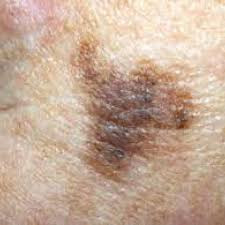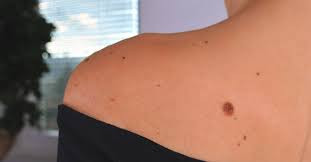Definisi
Nevus, atau nevus melanositik, dikenal juga dengan tahi lalat yang merupakan bentuk umum dari pertumbuhan kulit. Tahi lalat umumnya berukuran kecil, tampak spot atau area berwarna cokelat gelap, dan disebabkan oleh sekumpulan sel yang menghasilkan pigmen kulit (melanosit). Umumnya, selama anak dan remaja, terdapat sebanyak 10-40 tahi lalat pada permukaan kulit dan dapat berubah seiring bertambahnya usia.
Kebanyakan tahi lalat tidak berbahaya dan jarang menjadi sel kanker. Meskipun demikian, Anda perlu memeriksa secara berkala terhadap tahi lalat yang Anda miliki sebab bisa saja berkembang menjadi sel kanker kulit terutama melanoma maligna.
Hampir setiap orang memiliki setidaknya satu nevus melanositik di permukaan kulitnya. Sekitar 1% dari individu yang lahir dengan satu atau lebih nevus melanositik kongenital (tahi lalat semenjak dilahirkan). Individu dengan kulit putih cenderung memiliki lebih banyak nevus melanositik dibandingkan dengan individu dengan kulit lebih hitam. Nevus melanositik yang didapatkan saat usia anak atau dewasa dapat dipengaruhi oleh paparan sinar matahari dan dapat hilang sendiri.
Penyebab
Penyebab munculnya nevus hingga saat ini belum diketahui dengan pasti. Tidak ada pengaruh genetik atau lingkungan yang bermakna dan berkontribusi untuk tumbuhnya nevus. Meskupun demikian, ada beberapa studi yang menyatakan bahwa ada beberapa faktor seperti lokasi di tubuh, faktor lingkungan dan faktor evolusi nevus yang berperan untuk timbulnya nevus pada seseorang. Ada juga dugaan bahwa nevus displastik diturunkan secara genetik berupa autosomal dominan (diturunkan melalui keluarga).
Tumbuhnya tahi lalat disebabkan oleh sel-sel di kulit yang dikenal juga dengan melanosit tumbuh di dalam suatu kelompok bersama. Umumnya sel melanosit tersebar di sepanjang permukaan kulit. Sel inilah yang menghasilkan warna kulit yang disebut melanin (pigmen alami yang memberikan warna pada permukaan kulit individu).
Faktor Risiko
Faktor risiko untuk munculnya nevus terkadang dipengaruhi oleh faktor genetik atau faktor lingkungan. Nevus melanositik umumnya bersifat jinak sehingga bisa saja hilang sendirinya dalam beberapa kasus tertentu. Kulit berwarna putih dan usia dapat menjadi faktor risiko lainnya yang dapat memicu terbentuknya nevus melanositik.
Hal yang perlu diwaspadai apabila Anda memiliki faktor risiko dimana nevus atau tahi lalat yang ada menjadi melanoma (kanker kulit). Beberapa faktor risiko melanoma meliputi memiliki pekerjaan atau bekerja yang sering terpapar dengan sinar ultraviolet yang berasal dari sinar matahari, memiliki riwayat keluarga yang menderita melanoma, status ekonomi yang rendah (kemiskinan), rendahnya pengetahuan mengenai melanoma.
Melanoma merupakan kanker kulit yang biasanya ditandai oleh tahi lalat yang berubah bentuk menjadi tidak beraturan, ukuran yang bertambah besar lebih dari 6 milimeter, tepi atau batas tahi lalat yang tidak tegas, tahi lalat yang memiliki warna beragam, dan terkadang mudah berdarah.
Gejala
Gejala dan tanda tahi lalat biasanya tampak bercak atau bintil kecil berwarna coklat. Meskipun demikian, tahi lalat dapat memiliki variasi warna, bentuk, atau ukuran. Tahi lalat dapat berwarna coklat, hitam, biru, merah atau merah muda dengan tekstur yang halus atau meninggi dan terkadang disertai dengan adanya pertumbuhan rambut. Kebanyakan bentuk tahi lalat berupa oval dan ukurannya kurang dari 6 milimeter.
Tahi lalat dapat muncul sejak lahir yang dikenal dengan nevus kongenital dan ukurannya bisa lebih besar daripada umumnya, dapat ditemukan di wajah atau anggota gerak tubuh.
Diagnosis
Penegakkan diagnosis nevus, atau tahi lalat dapat dilakukan melalui wawancara medis, pemeriksaan fisik berupa adanya tahi lalat atau bercak atau bintik yang berwarna coklat hingga hitam yang khas, dan pemeriksaan penunjang dengan dermoskopi untuk membantu dan lebih memastikan bahwa tahi lalat yang ada merupakan tumor jinak.
Sebaiknya Anda beritahu dokter bila Anda atau seseorang di keluarga Anda pernah mengalami melanoma (kanker kulit) sebelumnya sebab tahi lalat dapat menjadi kanker apabila memiliki beberapa faktor risiko yang mendukung ke arah melanoma. Informasi seperti kapan pertama kali gejala muncul juga akan membantu dokter mendiagnosis dan menentukan penanganan terbaik pada saat pasien pertama kali diperiksa oleh dokter.
Apabila dokter mencurigai adanya tahi lalat yang bersifat ganas atau berpotensi menjadi kanker, maka tahi lalat tersebut akan diangkat melalui proses pembedahan dan dikirim ke laboratorium untuk dilakukan pemeriksaan di bawah mikroskop.
Tata Laksana
Hingga saat ini tidak ada obat-obatan khusus untuk menangani tahi lalat. Secara umum, tahi lalat merupakan benjolan atau tumor jinak. Apabila Anda merasa terganggu secara kosmetik, dokter akan melakukan pembedahan untuk menghilangkan tahi lalat dengan beberapa metode khusus yang perlu dikonsultasikan dan dibicarakan bersama. Apabila nevus atipikal (tidak khas) ditemukan, dokter akan melakukan biopsi terlebih dahulu lalu melakukan proses pembedahan.
Komplikasi
Nevus umumnya tidak memiliki komplikasi khusus. Meskipun demikian, adanya tindakan bedah minor saat melakukan biopsi atau pengambilan jaringan kecil atau pembuangan jaringan melalui pembedahan dapat memicu timbulnya komplikasi, misalnya infeksi atau perdarahan.
Komplikasi yang dapat muncul lainnya adalah melanoma. Beberapa orang yang memiliki tahi lalat memiliki risiko yang lebih tinggi untuk munculnya melanoma (kanker kulit). Beberapa faktor risiko yang dapat meningkatkan risiko melanoma adalah terlahir dengan nevus besar berukuran 5 cm, memiliki banyak nevus lebih dari 50 buah, memiliki nevus berukuran besar dan bentuk tidak teratur yang dikenal dengan nevus atipikal atau displastik.
Pencegahan
Pencegahan diperlukan untuk menghindari komplikasi yang dapat timbul dari sebuah nevus, yaitu melanoma. Ada beberapa langkah yang dapat dilakukan untuk mengetahui lebih dini perubahan nevus menjadi melanoma. Berikut langkah-langkah yang dapat Anda lakukan:
- Perhatikan apabila ada perubahan pada tahi lalat yang Anda miliki dengan melakukan pemeriksaan kulit sendiri setiap bulan dan hal yang perlu dinilai adalah bentuk, batas, warna, atau ukurannya
- Lindungi kulit Anda dari paparan sinar ultraviolet dengan tabir surya minimal mengandung SPF 30
- Bila tidak ada tabir surya, penggunaan benda penghalang fisik sinar matahari seperti payung atau topi dapat dimanfaatkan oleh Anda
Selain langkah-langkah diatas, apabila Anda tidak pernah memeriksakan diri ke dokter, sebaiknya lakukan pemeriksaan umum dan bila ditemukan kondisi atau penyakit yang dapat meningkatkan risiko Anda mengalami melanoma, maka dokter akan menyarankan untuk mulai pengobatan sedini mungkin sebelum kondisi semakin parah dan berat.
Kapan Harus ke Dokter?
Jika Anda mendapatkan bahwa tahi lalat Anda memiliki perubahan yang bermakna seperti ukuran yang makin lama bertambah besar, mudah berdarah, bentuk tahi lalat menjadi tidak beraturan, warna tahi lalat menjadi beragam warna atau tidak sewarna antara satu sisi dengan sisi lainnya, sebaiknya Anda memeriksakan diri lebih lanjut ke dokter spesialis kulit dan kelamin (Sp.KK) atau spesialis dermatologi dan venerologyi (Sp.DV). Dokter akan melakukan wawancara medis, pemeriksaan fisik, hingga pemeriksaan penunjang tertentu untuk menetapkan diagnosis pasti dan tata laksana yang tepat dan sesuai.
Mau tahu informasi seputar penyakit lainnya? Cek di sini, ya!
- dr Nadia Opmalina
Bodman MA, Al Aboud AM. Melanocytic Nevi. [Updated 2022 May 1]. In: StatPearls [Internet]. Treasure Island (FL): StatPearls Publishing; 2022 Jan-. Available from: https://www.ncbi.nlm.nih.gov/books/NBK470451/
Medscape. Melanocytic nevi. November 2019. https://emedicine.medscape.com/article/1058445-overview#a4
Dermnet NZ. Melanocytic naevus. January 2016. https://dermnetnz.org/topics/melanocytic-naevus
Mayo Clinic. Moles. May 2022. https://www.mayoclinic.org/diseases-conditions/moles/symptoms-causes/syc-20375200











